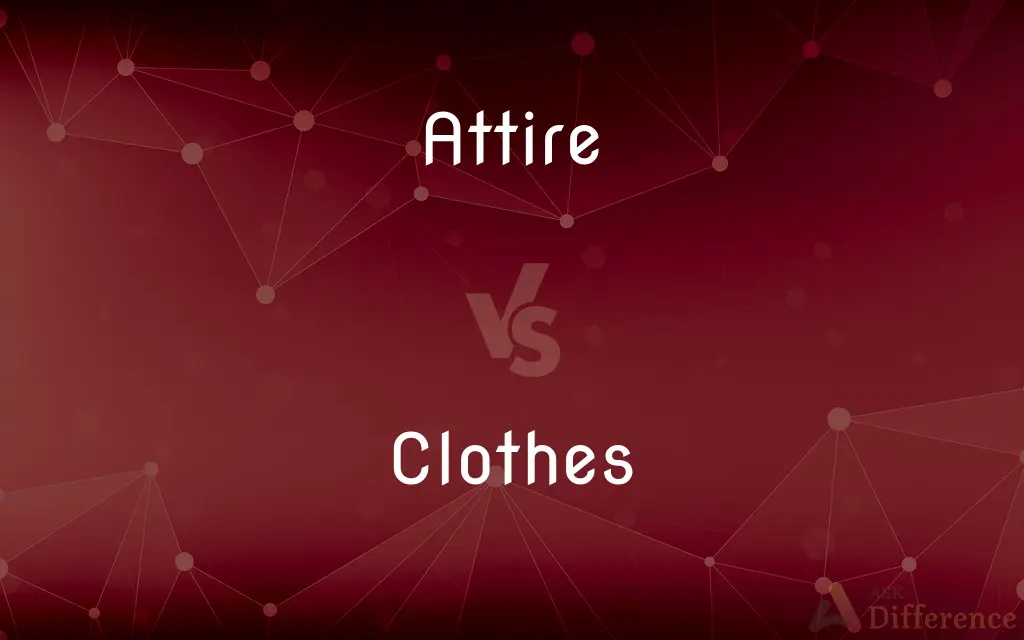Attire vs. Clothes — What's the Difference?
Edited by Tayyaba Rehman — By Maham Liaqat — Updated on April 2, 2024
Attire refers to a specific set of clothes worn for a particular occasion or purpose, emphasizing formality and distinction, while clothes are general garments worn to cover the body, focusing on practicality and everyday use.

Difference Between Attire and Clothes
Table of Contents
ADVERTISEMENT
Key Differences
Attire often implies a certain level of formality and is chosen to suit specific occasions, such as business attire for work or formal attire for weddings. Clothes, on the other hand, encompass all kinds of garments, from casual t-shirts and jeans to formal gowns and suits, serving the primary purpose of covering the body and protecting it from the environment.
While attire can denote a specialized or prescribed set of clothing for professional, ceremonial, or other specific activities, emphasizing appropriateness and conformity, clothes simply refer to garments in general without necessarily indicating a particular context or level of formality.
Attire is frequently associated with social status, profession, or cultural norms, suggesting a certain standard or expectation to be met. Clothes, whereas, are more neutral, focusing on the wearer's choice and comfort without implying a specific societal or situational requirement.
In discussing attire, one often considers the entire ensemble, including accessories and complementary items that complete a look for a particular setting or purpose. Clothes, on the other hand, may not always include these additional elements, emphasizing the basic aspect of dressing.
The choice between attire and clothes can also reflect the speaker's or writer's perspective on fashion, formality, and function. Attire often carries a sense of deliberate selection and intentionality, while clothes denote the everyday, functional aspect of dressing.
ADVERTISEMENT
Comparison Chart
Definition
A set of clothes worn for a specific occasion or purpose.
Garments worn by people to cover the body.
Connotation
Formality, specificity, and appropriateness for an occasion.
General use, practicality, and everyday wear.
Usage Context
Professional, ceremonial, or specific activities.
Any context, from casual to formal.
Emphasis
Completeness of the ensemble and suitability.
Functionality and covering the body.
Relation to Social Norms
Indicates adherence to social, professional, or cultural standards.
More neutral, with less emphasis on meeting external expectations.
Compare with Definitions
Attire
Athletic attire.
Proper athletic attire, like running shoes and breathable fabrics, is required for the gym.
Clothes
Baby clothes.
They received a plethora of baby clothes at the shower, from onesies to tiny socks.
Attire
Formal attire.
The gala required formal attire, so guests arrived in tuxedos and evening gowns.
Clothes
Vintage clothes.
She loves shopping for vintage clothes that bring a unique style to her wardrobe.
Attire
Business attire.
The company's dress code specifies business attire, including suits and closed-toe shoes.
Clothes
Work clothes.
His work clothes are covered in paint and dust from his job at the construction site.
Attire
Wedding attire.
Guests were asked to wear garden party attire for the outdoor wedding.
Clothes
Winter clothes.
With the cold season approaching, she unpacked her winter clothes, including sweaters and coats.
Attire
Casual attire.
The invitation stated casual attire, so jeans and t-shirts were perfectly acceptable.
Clothes
Hand-me-down clothes.
Growing up, he often wore hand-me-down clothes from his older siblings.
Attire
To dress or clothe, especially in fine or elaborate garments.
Clothes
Items worn to cover the body
He stripped off his clothes
Baby clothes
A clothes shop
Attire
Clothing or array; apparel.
Clothes
Bedclothes
Rosie got into bed and pulled the clothes up to her nose
Attire
The antlers of a deer.
Clothes
(plural only) Items of clothing; apparel.
Attire
(clothing) One's dress; what one wears; one's clothes.
He was wearing his formal attire.
Clothes
(obsolete) cloth.
Attire
(heraldry) The single horn of a deer or stag.
Clothes
The covering of a bed; bedclothes.
Attire
(transitive) To clothe or adorn.
We will attire him in fine clothing so he can make a good impression.
He stood there, attired in his best clothes, waiting for applause.
Clothes
Laundry (hung on a clothesline).
Attire
To dress; to array; to adorn; esp., to clothe with elegant or splendid garments.
Finely attired in a robe of white.
With the linen miter shall he be attired.
Clothes
Covering for the human body; dress; vestments; vesture; - a general term for whatever covering is worn, or is made to be worn, for decency or comfort.
She . . . speaks well, and has excellent good clothes.
If I may touch but his clothes, I shall be whole.
Attire
Dress; clothes; headdress; anything which dresses or adorns; esp., ornamental clothing.
Earth in her rich attire.
I 'll put myself in poor and mean attire.
Can a maid forget her ornament, or a bride her attire?
Clothes
The covering of a bed; bedclothes.
She turned each way her frighted head,Then sunk it deep beneath the clothes.
Attire
The antlers, or antlers and scalp, of a stag or buck.
Clothes
Clothing in general;
She was refined in her choice of apparel
He always bought his clothes at the same store
Fastidious about his dress
Attire
The internal parts of a flower, included within the calyx and the corolla.
Attire
Clothing of a distinctive style or for a particular occasion;
Formal attire
Battle dress
Attire
Put on special clothes to appear particularly appealing and attractive;
She never dresses up, even when she goes to the opera
The young girls were all fancied up for the party
Common Curiosities
What defines attire?
Attire is a set of clothes worn for a particular occasion, activity, or purpose, often with an emphasis on formality and suitability.
Are attire and clothes interchangeable terms?
While they can be used in similar contexts, attire usually implies a specific purpose or level of formality, unlike the more general term clothes.
Do attire and clothes have different cultural significances?
Yes, attire often carries cultural and social significances, reflecting societal norms and values, whereas clothes are more universally used to refer to any form of bodily covering.
Can the same garment be both attire and clothes?
Yes, a garment can be considered as part of an attire for a specific occasion and simply clothes in a broader sense.
How do professional settings differentiate between attire and clothes?
Professional settings often have dress codes specifying the type of attire required, highlighting the importance of appearance and suitability.
Does the choice of attire affect social perceptions?
Yes, attire can significantly influence how individuals are perceived in social and professional contexts, reflecting conformity, status, and personal style.
Are there cultural variations in what is considered appropriate attire?
Absolutely, cultural norms and traditions heavily influence what is deemed appropriate attire for different occasions and settings.
Why is the distinction between attire and clothes important?
The distinction highlights the purpose, formality, and context of dressing, reflecting cultural, social, and personal choices in dressing.
Is there a difference in formality between attire and clothes?
Generally, attire is associated with a specific level of formality or a particular purpose, while clothes encompass all forms of dress, from casual to formal.
How do personal preferences impact the choice of attire or clothes?
Personal preferences play a key role in choosing attire or clothes, reflecting individual style, comfort, and values.
Can casual clothes be considered attire?
Yes, casual clothes can be considered attire when they are chosen for a specific casual setting or activity, known as casual attire.
How do occasions influence the choice between attire and clothes?
Occasions dictate the level of formality and specificity, guiding whether one opts for particular attire or general clothes.
Is the concept of attire evolving?
Yes, the concept of attire is constantly evolving with fashion trends, social changes, and individual creativity.
What role does fashion play in defining attire?
Fashion influences the design, acceptance, and evolution of attire, shaping how specific occasions and purposes are visually represented through clothing.
How do environmental factors influence the choice of attire or clothes?
Environmental factors, such as climate and setting, significantly influence the selection of appropriate attire or clothes to ensure comfort and suitability.
Share Your Discovery

Previous Comparison
Aforementioned vs. Beforementioned
Next Comparison
Achilles vs. AgamemnonAuthor Spotlight
Written by
Maham LiaqatEdited by
Tayyaba RehmanTayyaba Rehman is a distinguished writer, currently serving as a primary contributor to askdifference.com. As a researcher in semantics and etymology, Tayyaba's passion for the complexity of languages and their distinctions has found a perfect home on the platform. Tayyaba delves into the intricacies of language, distinguishing between commonly confused words and phrases, thereby providing clarity for readers worldwide.
















































